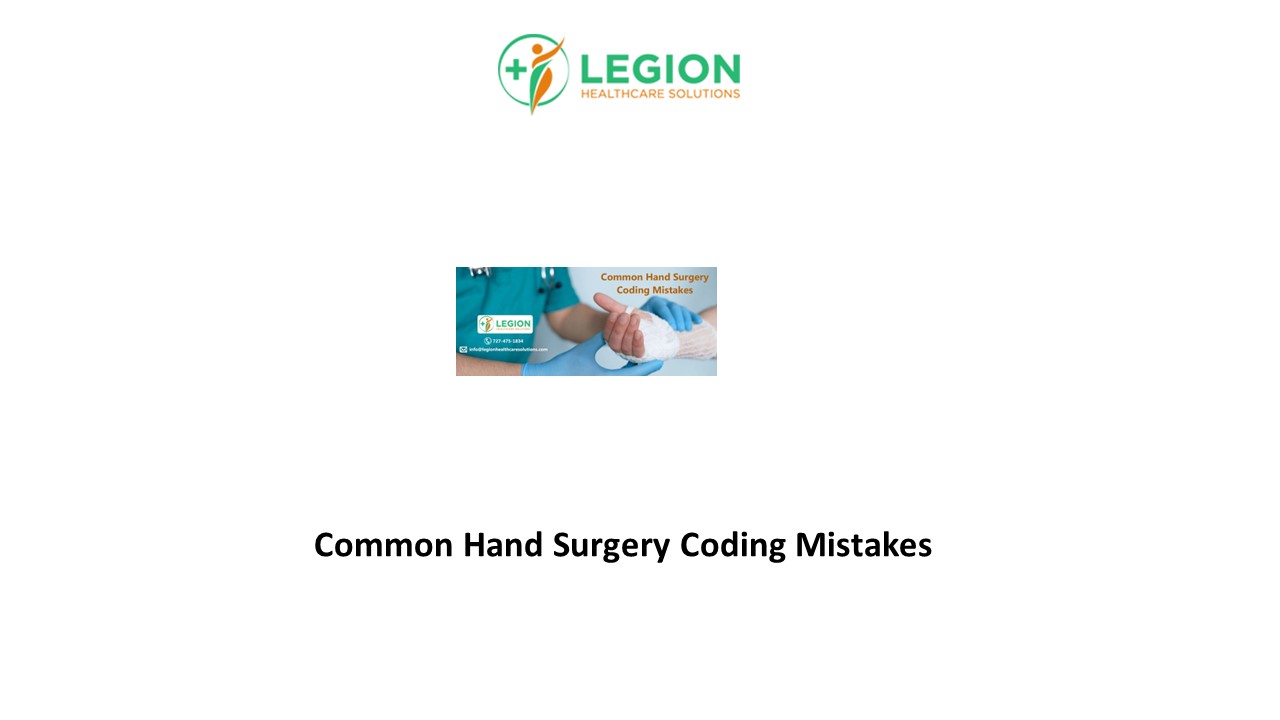Common Hand Surgery Coding Mistakes - PowerPoint PPT Presentation
Title:
Common Hand Surgery Coding Mistakes
Description:
Hand surgery coding plays an important role in accurately determining the procedure performed and quantifying the amount of work done by the surgeon. American Medical Association (AMA) updates and maintains the Current Procedural Terminology (CPT) codes applicable to hand surgery coding. The CPT code range for surgical procedures on the hand and fingers is 26010-26989. Despite the importance of accurate hand surgery coding, studies find that billers and surgeons are often unaware of proper billing codes. – PowerPoint PPT presentation
Number of Views:1
Title: Common Hand Surgery Coding Mistakes
1
Common Hand Surgery Coding
Mistakes
2
Common Hand Surgery Coding Mistakes
Hand Surgery Coding Basics Hand surgery coding
plays an important role in accurately determining
the procedure performed and quantifying the
amount of work done by the surgeon. American
Medical Association (AMA) updates and maintains
the Current Procedural Terminology (CPT) codes
applicable to hand surgery coding. The CPT code
range for surgical procedures on the hand and
fingers is 26010-26989. Despite the importance of
accurate hand surgery coding, studies find that
billers and surgeons are often unaware of proper
billing codes. Surgeon compensation structures
may influence patterns in the coding of
procedures. Coding errors, whether due to
fraudulence or inaccuracy, can lead to
substantial fines and civil penalties by the
Department of Health and Human Services. In this
article, we discussed common hand surgery coding
mistakes and avoiding them could help your
orthopedic practice to gain accurate
reimbursement and stay compliant in payer
audit. Common Hand Surgery Coding Mistakes 1.
Up-coding and Un-bundling Poor coding practices,
including up-coding and unbundling, are forms of
coding fraud and can have detrimental effects on
orthopedic practices. Up-coding refers to
submitting a CPT code for a procedure of higher
reimbursement value than the actual procedure
performed and is an unethical violation by CMS
guidelines. Conversely, down-coding refers to
coding at a lower level than the services
provided and is often done due to fear of
external payer audits. Unbundling is the coding
of procedures separately when they have a shared
code.
3
Common Hand Surgery Coding Mistakes
Although the surgeon is not always responsible
for the coding of procedures, he or she is
ultimately liable for violations. For this
reason, surgeons delegating this task must review
coding for their patients to prevent
violations. 2. Defining Location
Specificity Current Procedural Terminology (CPT)
includes references to specific locations in the
forearm, wrist, hand, and fingers for reporting
flexor and extensor tendon repair codes. Coders
often makes mistake of selecting codes based on
the site of tendon insertion and not on the
location of the repair. In particular, zone 2
flexor tendon repairs in the hand are important,
as a separate CPT code is used to describe such
procedures. Location specificity also is
essential in fracture management reporting. An
example is distal radius fractures, which require
documentation of whether the fracture is extra-
or intra-articular. If intra-articular, the
operative note must specify the number of
fragments (one to two or three or more). Be
consistent when creating the operative note
procedure list and documenting operative detail
within the note body. 3. Higher Value wRVU In
contrast to salaried surgeons, surgeons subject
to the collections or wRVU model have more to
gain financially from using additional codes and
selecting higher-valued RVU procedures. Recent
survey found that 23 percent surgeons increased
the procedures and tests offered or the time
spent with the patient in order to maximize
profits. Productivity-based compensation (wRVU)
always encouraged higher rates of procedures.
4
Common Hand Surgery Coding Mistakes
4. CPT Codes 64718 and 24305 CPT code 64718 is
used to describe Transposition and/or neuroplasty
of the ulnar nerve at the elbow. This code is
used commonly to report simple decompression of
the ulnar nerve, such as anterior transposition
or subcutaneous transposition. Instead, surgeons
may perform a submuscular transposition, which
also is reportable as 64718. If the physician
performs tendon lengthening as a component of the
submuscular transposition, a secondary CPT code
may be reportable 24305, Tendon lengthening,
upper arm or elbow, each tendon. Because there is
no NCCI edit between codes 24305 and 64718, it is
not necessary to use modifier 59 for this code
combination. 5. Separately Coding for
Debridement Debridement is considered a separate
procedure only when gross contamination requires
prolonged cleansing, when appreciable amounts of
devitalized or contaminated tissue are removed,
or when Debridement is carried out separately
without immediate primary closure. For example,
separate reporting of Debridement from the
1104211047 series of CPT codes would not be
allowed in conjunction with an open wound with a
tendon laceration, unless the criteria above are
met and well documented in the operative report.
CPT does allow separate reporting of excisional
Debridement from the 1101011012 series of CPT
codes in conjunction with open fractures or
dislocations with appropriate documentation of
medical necessity.
5
Common Hand Surgery Coding Mistakes
As mentioned earlier, poor coding practices could
have detrimental effect on any orthopedic
practice. You must seek help from expert
orthopedic coders for accurate orthopedic coding.
Legion Healthcare Solutions is a leading medical
billing company providing complete orthopedic
billing and coding services. To know how you can
avoid common hand surgery coding mistakes and to
know more about our orthopedic billing services,
contact us at contact us at 727-475-1834 or email
us at info_at_legionhealthcaresoltions.com
6
(No Transcript)







![NOTE:%20To%20appreciate%20this%20presentation%20[and%20ensure%20that%20it%20is%20not%20a%20mess],%20you%20need%20Microsoft%20fonts:%20%20 PowerPoint PPT Presentation](https://s3.amazonaws.com/images.powershow.com/P1247176264UDuye.th0.jpg?_=201805141011)


![NOTE:%20To%20appreciate%20this%20presentation%20[and%20insure%20that%20it%20is%20not%20a%20mess],%20you%20need%20Microsoft%20fonts:%20%20 PowerPoint PPT Presentation](https://s3.amazonaws.com/images.powershow.com/P1252428420wZXYW.th0.jpg?_=20180601048)





![NOTE: To appreciate this presentation [and ensure that it is not a mess], you need Microsoft fonts: PowerPoint PPT Presentation](https://s3.amazonaws.com/images.powershow.com/5528768.th0.jpg?_=202007270510)
![NOTE: To appreciate this presentation [and ensure that it is not a mess], you need Microsoft fonts: PowerPoint PPT Presentation](https://s3.amazonaws.com/images.powershow.com/5816511.th0.jpg?_=20200718068)




![NOTE: To appreciate this presentation [and insure that it is not a mess], you need Microsoft fonts: PowerPoint PPT Presentation](https://s3.amazonaws.com/images.powershow.com/7010443.th0.jpg?_=20150809053)








